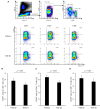The Suppression of Th1 Response by Inducing TGF-β1 From Regulatory T Cells in Bovine Mycoplasmosis
- PMID: 33344537
- PMCID: PMC7738317
- DOI: 10.3389/fvets.2020.609443
The Suppression of Th1 Response by Inducing TGF-β1 From Regulatory T Cells in Bovine Mycoplasmosis
Abstract
Regulatory T cells (Tregs) regulate immune responses and maintain host immune homeostasis. Tregs contribute to the disease progression of several chronic infections by oversuppressing immune responses via the secretion of immunosuppressive cytokines, such as transforming growth factor (TGF)-β and interleukin-10. In the present study, we examined the association of Tregs with Mycoplasma bovis infection, in which immunosuppression is frequently observed. Compared with uninfected cattle, the percentage of Tregs, CD4+CD25highFoxp3+ T cells, was increased in M. bovis-infected cattle. Additionally, the plasma of M. bovis-infected cattle contained the high concentrations of TGF-β1, and M. bovis infection induced TGF-β1 production from bovine immune cells in in vitro cultures. Finally, we analyzed the immunosuppressive effects of TGF-β1 on bovine immune cells. Treatment with TGF-β1 significantly decreased the expression of CD69, an activation marker, in T cells, and Th1 cytokine production in vitro. These results suggest that the increase in Tregs and TGF-β1 secretion could be one of the immunosuppressive mechanisms and that lead to increased susceptibility to other infections in terms of exacerbation of disease during M. bovis infection.
Keywords: Mycoplasma bovis; TGF-β1; cattle; immunosuppression; regulatory T cell.
Copyright © 2020 Sajiki, Konnai, Goto, Okagawa, Ohira, Shimakura, Maekawa, Gondaira, Higuchi, Tajima, Hirano, Kohara, Murata and Ohashi.
Conflict of interest statement
The authors declare that the research was conducted in the absence of any commercial or financial relationships that could be construed as a potential conflict of interest.
Figures





Similar articles
-
Bovine leukemia virus reduces anti-viral cytokine activities and NK cytotoxicity by inducing TGF-β secretion from regulatory T cells.Immun Inflamm Dis. 2016 Jan 18;4(1):52-63. doi: 10.1002/iid3.93. eCollection 2016 Mar. Immun Inflamm Dis. 2016. PMID: 27042304 Free PMC article.
-
Transforming growth factor-beta1-induced CD4+CD25+ regulatory T cells in vitro reverse and prevent a murine lupus-like syndrome of chronic graft-versus-host disease.Br J Dermatol. 2008 Jun;158(6):1197-209. doi: 10.1111/j.1365-2133.2008.08555.x. Epub 2008 Apr 10. Br J Dermatol. 2008. PMID: 18410422
-
Canine Transforming Growth Factor-β Receptor 2-Ig: A Potential Candidate Biologic for Melanoma Treatment That Reverses Transforming Growth Factor-β1 Immunosuppression.Front Vet Sci. 2021 Jun 14;8:656715. doi: 10.3389/fvets.2021.656715. eCollection 2021. Front Vet Sci. 2021. PMID: 34195245 Free PMC article.
-
Garp as a therapeutic target for modulation of T regulatory cell function.Expert Opin Ther Targets. 2017 Feb;21(2):191-200. doi: 10.1080/14728222.2017.1275568. Epub 2016 Dec 29. Expert Opin Ther Targets. 2017. PMID: 28001437 Review.
-
The inhibitory effects of transforming growth factor-beta-1 (TGF-beta1) in autoimmune diseases.J Autoimmun. 2000 Feb;14(1):23-42. doi: 10.1006/jaut.1999.0339. J Autoimmun. 2000. PMID: 10648114 Review.
Cited by
-
Breast cancer stem cells generate immune-suppressive T regulatory cells by secreting TGFβ to evade immune-elimination.Discov Oncol. 2023 Dec 1;14(1):220. doi: 10.1007/s12672-023-00787-z. Discov Oncol. 2023. PMID: 38038865 Free PMC article.
-
Cytotoxic T-lymphocyte antigen 4 and programmed cell death ligand 1 blockade increases the effectiveness of interleukin-15 immunotherapy in a bovine leukemia model.Vet World. 2024 Sep;17(9):2096-2103. doi: 10.14202/vetworld.2024.2096-2103. Epub 2024 Sep 15. Vet World. 2024. PMID: 39507777 Free PMC article.
-
Prostaglandin E2-Induced Immune Suppression via Cytotoxic T-Lymphocyte Antigen 4 in Paratuberculosis.Infect Immun. 2022 Oct 20;90(10):e0021022. doi: 10.1128/iai.00210-22. Epub 2022 Sep 14. Infect Immun. 2022. PMID: 36102658 Free PMC article.
-
Kangayam and Tharparkar cattle exhibit higher duplications in innate immune genes compared to Sahiwal, Gir, Karan Fries, and Holstein Friesian: insights from an array comparative genomic hybridization.Mamm Genome. 2025 Sep;36(3):812-826. doi: 10.1007/s00335-025-10136-w. Epub 2025 May 31. Mamm Genome. 2025. PMID: 40448838
-
Candidate genes associated with heat stress and breeding strategies to relieve its effects in dairy cattle: a deeper insight into the genetic architecture and immune response to heat stress.Front Vet Sci. 2023 Sep 13;10:1151241. doi: 10.3389/fvets.2023.1151241. eCollection 2023. Front Vet Sci. 2023. PMID: 37771947 Free PMC article. Review.
References
LinkOut - more resources
Full Text Sources
Research Materials

